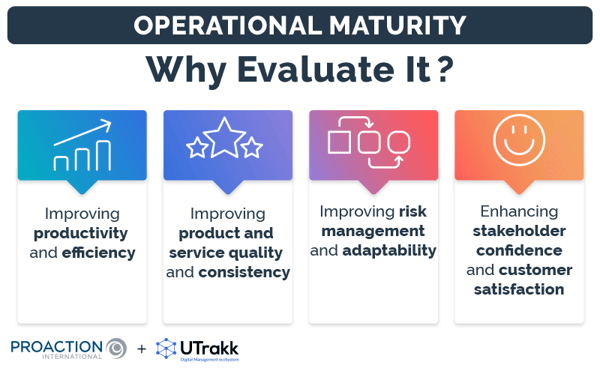What is operational maturity?
Operational maturity (or process maturity) is a concept used to assess an organization's degree of development, competence, and efficiency in achieving its objectives and optimizing its operations.
The goal here is to achieve higher operational maturity levels and become top performers. These levels vary depending on the industry and context, but here are the most commonly used:

Operational maturity level 1 – Beginning
- The organization has few defined, controlled processes.
- Low to negative financial performance and inconsistent service quality performance.
- Activities are often chaotic, reactive, and undocumented.
- The organization lacks established standards and procedures.
Operational maturity level 2 – Emerging
- The organization has basic processes in place. Even though these processes are documented, the execution is often ad hoc.
- There are efforts to standardize practices across the organization, but they are not fully implemented.
- There are few controls and little forward planning.
Operational maturity level 3 – Scaling
- Processes are well-documented, standardized, and widely adopted within the organization.
- Formal procedures exist for project management, production management, supply management, quality management, and other business-critical areas.
- The organization strives to optimize its processes and follow specific quality standards.
Operational maturity level 4 – Optimizing
- The organization regularly monitors the performance of its industrial processes and strives for continuous improvement.
- Processes are proactively monitored to ensure they remain aligned with strategic objectives.
- Risk management is integrated into operational decisions.
- Robust controls are enforced.
Operational maturity level 5 – Innovating
- The organization has reached the highest financial performance, value, and service quality.
- An excellent level of efficiency and agility is achieved.
- Continuous improvement is an integral part of the corporate culture.
- Processes are designed to evolve and adapt to change.
Key tools and methodologies for assessing the operational maturity of your organization
Capability Maturity Model Integration (CMMI)
CMMI is an operational maturity model widely used to measure and improve the maturity of management and engineering practices within an organization.
It identifies gaps in operational processes, defines improvement objectives, and implements action plans to achieve higher maturity levels and ensure positive business outcomes.
Lean Manufacturing
This approach aims to eliminate waste and maximize customer value in manufacturing operations.
When assessing operational maturity, applying Lean principles can help identify inefficiencies, speed up workflows, reduce costs, and increase product quality. By using Lean tools such as 5S, Kanban, and Kaizen, an organization can assess its ability to optimize processes and reduce waste.
Six Sigma
This methodology involves reducing the variability of operational processes to achieve high quality and performance.
Operational maturity assessment can use Six Sigma to measure and improve process performance. The DMAIC approach specifically can be used to evaluate, analyze, and optimize processes, reduce defects, and increase customer satisfaction.
These complementary tools and methodologies can be used together to achieve operational excellence.
How to assess the operational maturity of a company
Assessing the maturity of a company's operations can be a complex project. However, to make it as effective and straightforward as possible, we have identified the main steps to follow:
1. Define the assessment objective
Before starting an assessment, it's essential to define your objective clearly:
- What operational areas or processes do you want to evaluate?
- What are the long-term objectives of the assessment? For example, to increase production line performance by 25% or improve safety procedures to reduce employee accidents by 50%.
- What key performance indicators will be used to measure these objectives?
2. Select a model or framework
Choose the model or framework that best matches the objective of your assessment (CMMI, Lean Manufacturing, Six Sigma, ISO 9001, etc.).
3. Collect data
Gather data that is relevant to your operational maturity assessment. This can be done through employee interviews, audits of procedures and processes, or a daily management system.
The data collected should be used to measure the progress made toward your key performance indicators. This will help you understand where you stand in your journey towards operational excellence.
4. Analyze current practices
Analyze the organization's current practices against the criteria of the model or framework.
Determine how closely the organization aligns with standards and best practices. To this end, evaluation grids listing current standards and practices, as well as the level of compliance with each, can be helpful in pinpointing gaps.
5. Identifying gaps
Using your assessment grid or any other tool, identify gaps or areas where the organization needs to work on to achieve the desired maturity level. It will enable you to target areas requiring improvement, e.g., the implementation of rigorous industry standards or the training and coaching of leaders.
6. Define an improvement plan
Outline an improvement plan for each operational area or process where shortcomings have been identified. It should include specific objectives, actions to take, responsibilities, and a timeline.
7. Implement improvements
Implement the actions defined in the improvement plan. Be sure to monitor progress and adjust as necessary.
8. Communicate results
Communicate assessment results and progress to the whole organization. Celebrate successes to boost employee engagement and motivation.
9. Maintain the improvement effort
Your efforts to maintain operational maturity must be constant. Keep assessing, adjusting, and improving practices to remain effective and flexible in times of change.
It's important to note that each operational maturity assessment is unique, as it depends on the specific needs of your organization and the chosen model or framework.
What are the benefits of undertaking such an assessment?
Generally speaking, an operational maturity assessment enables companies to identify their strengths and weaknesses, define improvement objectives, define action plans, and measure progress over time.
Here are the main benefits:

Improved productivity and efficiency
The operational maturity assessment identifies inefficient processes, bottlenecks, and waste.
So a company can streamline operations, eliminate unnecessary tasks, and reduce waiting times.
As a result, processes are optimized, leading to higher productivity, lower production costs, more efficient use of resources, and better financial performance.
Improved product and service quality and consistency
By identifying problems in product manufacturing or service delivery processes, the company can take steps to eliminate errors and defects. This results in improvements in the quality and consistency of the products or services offered.
Improved risk management and adaptability
An operational maturity assessment can help identify and mitigate potential risks.
It also enables the organization to develop specific improvement plans to strengthen risk management, make more informed decisions, and be better prepared and more flexible in unforeseen situations.
Enhanced stakeholder confidence and customer satisfaction
By demonstrating its commitment to continuous improvement and quality, organizations strengthen the confidence of their stakeholders, including investors and employees.
Transparency in operational processes and management builds a stronger company reputation, which can attract new customers and business partners.
Finally, enhancing the quality of products or services helps improve the customer experience, and therefore increases their satisfaction and loyalty.
Assess operational maturity for long-term success
Operational maturity is a critical factor in the success and sustainability of your organization. By measuring it, you can improve your operational processes, optimize your results, and reach new heights of employee and financial performance.
With tools and methodologies such as CMMI, Lean Manufacturing, and Six Sigma, organizations can assess, improve, and maintain their level of operational maturity. This assessment helps identify improvement opportunities and implement action plans, creating a culture of continuous improvement and innovation that ensures optimal productivity, product and service quality, and customer satisfaction.
Ultimately, investing in operational maturity assessment is not only a guarantee of current performance, but also an assurance of long-term success.









